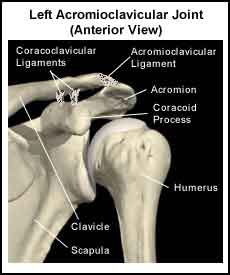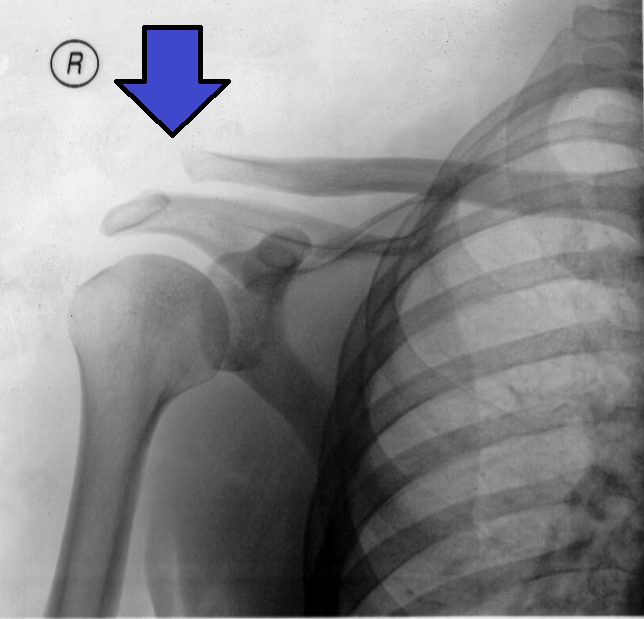In order to understand this condition, it is important to understand the anatomy and function of the shoulder. Please read Shoulder Pain Info’s section on basic shoulder anatomy. For additional background information on the biomechanics of the shoulder please read Shoulder Pain Info’s section on basic shoulder biomechanics. It may also be useful to learn more about tissue healing times.

What is the anatomy of acromioclavicular (AC) joint?
The shoulder complex is made up of three bones, which are connected by muscles, ligaments, and tendons. The large bone in the upper arm is called the humerus. The shoulder blade is called the scapula and the collarbone is called the clavicle.
The acromioclavicular joint of the shoulder complex is where the outer (lateral) part of the clavicle is joined to a projection on the top of the scapula known as the acromion process. The joint connecting these two bones is known as the acromioclavicular (AC) joint. The AC joint allows a small amount of movement to occur between clavicle and the acromion process.
Ligaments are like strong ropes that help connect bones and provide stability to joints. In the AC joint there are three main ligaments. The acromioclavicular ligament connects the acromion process and the clavicle. The coracoclavicular ligaments (the trapezoid ligament and conoid ligament) connect the clavicle with another projection of the scapula called the corocoid process.

Jay F. Cox (2006), CC BY 2.5 https://creativecommons.org/licenses/by/2.5, via Wikimedia Commons
What is an AC joint separation?
An AC joint separation occurs when the ligaments that stabilize the clavicle to the acromion process are injured or torn. As a result the clavicle can be displaced (moved) upwards. This condition is commonly known as a shoulder separation.
There are different severities of AC joint separation. Classification of the different severities depends on the ligaments that are torn. One classification is as follows:
Type I: A sprain (without a complete tear) of either of the ligaments holding the joint together. The clavicle is not displaced.
Type II: A complete tear of the acromioclavicular ligament and a partial tear of the coracoclavicular ligaments. The clavicle is slightly displaced.
Type III: A complete tear of both the acromioclavicular ligament and the coracoclavicular ligaments. When this occurs the clavicle is severely displaced (dislocated).
Types IV, V, VI: A complete tear of the acromioclavicular ligament and the coracoclavicular ligaments. The clavicle is severely dislocated and usually requires surgical intervention.
What can cause an AC joint separation?
Injuries to the AC joint are usually caused by a direct blow to the shoulder. Traumatic contact from the side or from above the shoulder can tear the AC ligaments. Hockey players and football players commonly injure this joint when they make contact with the boards, ground or an opponent with their shoulder striking first.
Injuries to the AC joint can also be caused by overstressing the joint with heavy weightlifting (i.e. deep bench-press techniques). This mechanism of injury is rare.
What does an AC joint separation feel like?
Immediately following an AC joint separation there is usually pain and swelling on the top of the shoulder. Depending on the severity of the injury, there may be some visible displacement of the clavicle.
Activities such as pushing and pulling, reaching overhead and across the body will usually create pain in an acutely (recently) separated AC joint. Over time (usually 6 – 8 weeks or more) there may be little pain associated with an AC joint separation.
Learn more about tissue healing times.
Can an AC joint separation be detected on X-rays?
X-rays are an effective tool for identifying AC joint separations. X-rays are usually taken while holding a weight in each hand to stress the joint and determine the degree of injury.
O’Brien’s Test and Scarf Test (Cross Arm Adduction Test) are orthopedic special tests that a physician or physical therapist may use tell help to diagnose AC Joint separation.
What is the treatment for an AC joint separation?
The treatment of AC joint separations depends on the severity of the injury.
Treatment immediately following Type I and Type II AC joint separations may include an arm sling, icing, taping, pain medications and rest. As the symptoms improve a range of motion and strengthening program, as recommended by a physician and/or physical therapist, may begin. Individuals returning to sport can benefit from padding (a doughnut pad) over the AC joint to help protect the joint.
Treatment following a Type III, IV, V and VI AC joint separation is more involved. In some cases surgery may be required to re-locate the clavicle. In other cases a non-operative approach may be chosen.
What other information is available on AC joint separations?
Shoulder Pain Info’s links section has additional information on this topic. Links have been provided to other websites as well as online medical journals.
